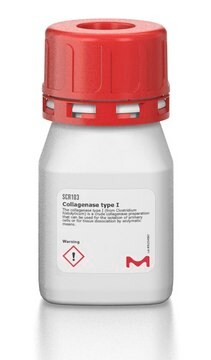C1764
Collagenase from Clostridium histolyticum
0.2 μm filtered, suitable for release of physiologically active rat epididymal adipocytes, Type II-S, 0.5-5.0 FALGPA units/mg solid, ≥125 CDU/mg solid
Synonym(s):
Clostridiopeptidase A
Sign Into View Organizational & Contract Pricing
All Photos(2)
About This Item
Recommended Products
Quality Level
sterility
0.2 μm filtered
type
Type II-S
form
lyophilized powder
specific activity
≥125 CDU/mg solid
0.5-5.0 FALGPA units/mg solid
mol wt
68-125 kDa
suitability
suitable for release of physiologically active rat epididymal adipocytes
application(s)
diagnostic assay manufacturing
storage temp.
−20°C
Looking for similar products? Visit Product Comparison Guide
Application
Collagenase has been used in the preparation of arterial tissue for the study of Advanced Glycosylation End Products (AGE). The enzyme has also been used along with other proteases for the disaggregation of human tumor, mouse kidney, human brain, lung epithelium and many other tissues. It is also effective in liver and kidney perfusion studies, digestion of pancreas, and isolation of nonparenchymal hepatocytes. It is also suitable for the preparation adipocytes from epididymal fat pads of rats.
Biochem/physiol Actions
Effective release of cells from tissue requires the action of both collagenase enzymes and the neutral protease. Collagenase is activated by four gram atom calcium (Ca2+) per mole enzyme. The culture filtrate is thought to contain at least 7 different proteases ranging in molecular weight from 68-130 kDa (pH optimum: 6.3-8.8). The enzyme recognizes the sequence -R-Pro-8-X-Gly-Pro-R-, where X is most often a neutral amino acid.
Collagenase is activated by four gram atom calcium per mole enzyme. It is inhibited by ethylene glycol-bis(beta-aminoethyl ether) - N, N, N′,N′-tetraacetic acid, beta-mercaptoethanol, glutathione, thioglycolic acid and 8-hydroxyquinoline.
Caution
As supplied, this product is stable for one year at -20°C. There is no loss in FALGPA or protease activity in 30 days at 37°C, 50°C and -20°C. Solutions of crude collagenase are stable if frozen quickly in aliquots (at 10 mg/mL) and kept frozen at -20°C. Further freeze-thaw cycles will damage the solution. The product retains 100% activity over 7 hours when held on ice.
Unit Definition
One collagen digestion unit (CDU) liberates peptides from collagen from bovine achilles tendon equivalent in ninhydrin color to 1.0 μmole of leucine in 5 hours at pH 7.4 at 37 °C in the presence of calcium ions. One FALGPA hydrolysis unit hydrolyzes 1.0 μmole of furylacryloyl-Leu-Gly-Pro-Ala per min at 25°C. One Neutral Protease unit hydrolyzes casein to produce color equivalent to 1.0 μmole of tyrosine per 5 hr at pH 7.5 at 37°C. One Clostripain Unit hydrolyzes 1.0 μmole of BAEE per min at pH 7.6 at 25°C in the presence of DTT.
Preparation Note
This product is prepared from Type II (C6885) Collagenase from Clostridium histolyticum. Solutions are typically prepared at 1-2 mg/mL in TESCA buffer (containing 50 mM TES, 0.36 mM Calcium chloride, pH 7.4 at 37°C. It also contains clostripain, nonspecific neutral protease, and tryptic activities.
substrate
Product No.
Description
Pricing
Signal Word
Danger
Hazard Statements
Precautionary Statements
Hazard Classifications
Eye Irrit. 2 - Resp. Sens. 1 - Skin Irrit. 2 - STOT SE 3
Target Organs
Respiratory system
Storage Class Code
11 - Combustible Solids
WGK
WGK 1
Flash Point(F)
Not applicable
Flash Point(C)
Not applicable
Personal Protective Equipment
dust mask type N95 (US), Eyeshields, Gloves
Choose from one of the most recent versions:
Already Own This Product?
Find documentation for the products that you have recently purchased in the Document Library.
Customers Also Viewed
Jessica M Kemppainen et al.
Biomaterials, 31(2), 279-287 (2009-10-13)
It has been widely postulated that scaffold permeability has a significant influence on chondrogenesis. However, since permeability has not been rigorously controlled in previous studies, there is no definitive conclusion as to how permeability affects cartilage regeneration by primary chondrocytes
Sachin S Thakur et al.
Experimental eye research, 194, 108006-108006 (2020-03-21)
Vitreous liquefactive processes play an integral role in ocular health. Knowledge of the degree of liquefaction would allow better monitoring of ocular disease progression and enable more informed therapeutic dosing for an individual patient. Presently this process cannot be monitored
Neža Adamič et al.
Stem cell research & therapy, 13(1), 23-23 (2022-01-23)
Severe equine asthma (SEA) is a common chronic respiratory disease and a significant health and well-being problem in horses. Current therapeutic strategies improve pulmonary function and clinical signs in some horses, but in the long-term, return to full athletic function
Jeffrey Dock et al.
PloS one, 12(8), e0182498-e0182498 (2017-08-24)
A hallmark of human immunosenescence is the accumulation of late-differentiated memory CD8+ T cells with features of replicative senescence, such as inability to proliferate, absence of CD28 expression, shortened telomeres, loss of telomerase activity, enhanced activation, and increased secretion of
Caroline Passaes et al.
Cell reports, 32(12), 108174-108174 (2020-09-24)
Highly efficient CD8+ T cells are associated with natural HIV control, but it has remained unclear how these cells are generated and maintained. We have used a macaque model of spontaneous SIVmac251 control to monitor the development of efficient CD8+ T cell
Our team of scientists has experience in all areas of research including Life Science, Material Science, Chemical Synthesis, Chromatography, Analytical and many others.
Contact Technical Service





